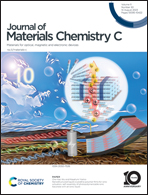Restriction of intramolecular bending (RIB) enables the quantitative design of AIEgens†
Abstract
Fluorescent compounds with aggregation-induced emission (AIE) characteristics (or AIEgens) have garnered significant research interest for various applications. The establishment of new AIE mechanisms coupled with quantitative prediction power is crucial to accelerate the development of novel AIE materials. Herein, we report the discovery of a new AIE mechanism, known as restriction of intramolecular bending (RIB), using computational chemistry and experimental validation. In RIB, the structural bending of the fluorophore scaffold caused by steric effects leads to fluorescence quenching in a dilute solution; fluorescence is only recovered in the aggregate state when the bending is inhibited. This RIB mechanism affords a practical guide for the quantitative molecular design of AIEgens, i.e., by converting traditional aggregation-caused quenching (ACQ) fluorophores to AIEgens through simple structural modifications. We believe that the introduction of the RIB mechanism paves a new avenue for the rational development of functional AIEgens.



 Please wait while we load your content...
Please wait while we load your content...